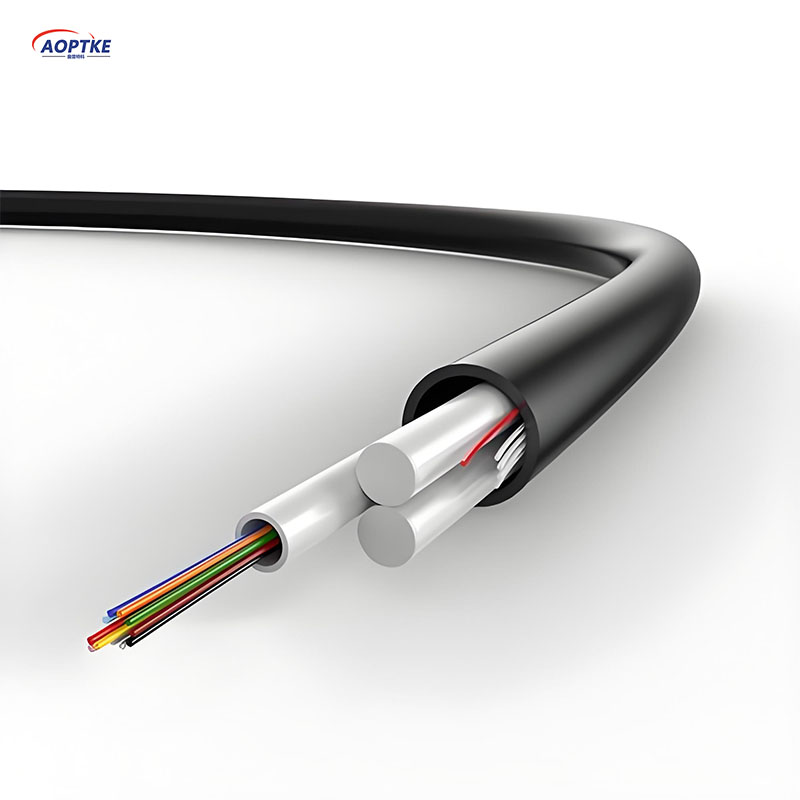With the acceleration of global power grid intelligence and 5G network construction, the limitations of traditional power optical cables in short spans and complex environments are becoming increasingly apparent.
What is ASU Cable?
ASU optical cable (also known as mini ADSS optical cable) is a non-metallic optical cable designed for overhead power lines. It combines a full dielectric structure with enhanced support technology to achieve long-span (80-120 meters) deployment without relying on external load-bearing wires. Its core features include:
·All-dielectric material: no metal parts, avoiding electromagnetic interference (EMI) and lightning strike risks.
·ASU enhanced technology: built-in aramid fiber and high-density polyethylene (HDPE) support unit, tensile strength of more than 20kN, sag rate lower than the industry standard.
·Lightweight design: The diameter is 25% smaller than the traditional ADSS optical cable, and the weight is as low as 100kg/km (taking 24 cores as an example), reducing the load pressure on the tower.
 |
Four points you must know when choosing ASU optical cable
Structural innovation: compactness and high density.
Cable core design: adopts layered stranding structure, the number of optical fiber cores supports 12-48 cores (mainstream specifications in the industry), and is suitable for the medium and short distance requirements of power communication.
Sheath material: weather-resistant PE or LSZH outer sheath, resistant to extreme temperatures from -40°C to +70°C, and a lifespan of more than 25 years.
Cost-effectiveness: lower cost over the entire life cycle.
Installation cost: No metal accessories are required, construction efficiency is increased by 30%, saving manpower and equipment investment.
Maintenance cost: Non-conductive properties reduce the probability of lightning damage, and the average annual maintenance cost is reduced by 40%.
Material cost: Light weight, small size, transportation and storage costs are reduced by 15%-20%.
Safety: Double protection mechanism
Anti-interference ability: The full dielectric structure avoids mutual interference with high-voltage power lines to ensure stable signal transmission.
Mechanical protection: Aramid reinforcement layer and wear-resistant sheath can withstand 12-level strong winds and long-term ultraviolet radiation.
ASU unique technology: long span and high reliability
Support unit optimization: HDPE unit disperses stress, supports 80-120 meters of large span overhead, and reduces the number of poles and towers.
Low-loss transmission: Optical fiber loss ≤0.36dB/km@1550nm, meeting the real-time monitoring needs of smart grids.
Global application hotspots of ASU optical cable
ASU optical cables have been widely used in power and communication projects in the following countries and regions:
1. Southeast Asia
Indonesia: A real-time monitoring system for high-voltage transmission lines on Java Island, deployed on the same pole as the power lines, reducing the cost of tower construction by 30%.
Vietnam: ASU optical cables are used in rural power grid transformation, shortening the construction period by 40%, covering more than 2,000 villages.
2. East Africa
Kenya: A national power grid project uses ASU optical cables to connect wind power bases, and its wind sway resistance has passed the 12-level wind test.
Ethiopia: ASU optical cables are deployed in plateau areas to adapt to extreme environments with a temperature difference of 50°C between day and night.
3. South America
Brazil: Distributed photovoltaic power stations used in the Amazon rainforest area have significant moisture and corrosion resistance.
Is ASU optical cable suitable for you? Three reasons to choose it.
1. Strong adaptability to scenarios: suitable for changing environments such as high-voltage transmission corridors, mountainous areas, and coastal areas, especially for infrastructure upgrade needs in emerging markets.
2. High return on investment: The comprehensive cost is 20% lower than that of traditional OPGW optical cables, and the life cycle is longer.
3. Forward-looking technology: Supports smart grids and 5G backhaul networks to meet the bandwidth expansion needs in the next 10 years.
Summary
ASU optical cable has achieved a balance between performance and economic benefits in the field of power communications through structural innovation and cost optimization. Its lightweight design, high reliability and wide applicability make it a core choice for power grid upgrades in emerging markets such as Southeast Asia and East Africa. For projects that pursue high cost-effectiveness and long-term stability, ASU optical cable is not only a technical solution, but also a strategic investment to reduce operational risks.
Post time: 2025-03-14 21:49:53
